Bard College Creative Writing Mfa
Private liberal arts college in Annandale-on-Hudson, New York
This article is about the college in New York state. For the affiliated "early college" in Massachusetts, see Bard College at Simon's Rock.
 | |
| Latin: Collegium Bardianum | |
| Motto | Dabo tibi coronam vitae (Latin) |
|---|---|
| Motto in English | I shall give thee the crown of life (Revelation 2:10) |
| Type | Private liberal arts college |
| Established | 1860; 161 years ago (1860) |
| Endowment | $267 million[1] |
| President | Leon Botstein |
| Academic staff | 257 |
| Undergraduates | 2,051 |
| Postgraduates | 161 |
| Location | Annandale-on-Hudson New York United States 42°01′13″N 73°54′36″W / 42.02028°N 73.91000°W / 42.02028; -73.91000 Coordinates: 42°01′13″N 73°54′36″W / 42.02028°N 73.91000°W / 42.02028; -73.91000 |
| Campus | Rural, 1,000 acres (400 ha) |
| Colors | Red and white[2] |
| Nickname | Raptors[3] |
| Sporting affiliations | NCAA Division III Liberty League |
| Website | www |
 | |
Bard College is a private liberal arts college in Annandale-on-Hudson, New York. The campus overlooks the Hudson River and Catskill Mountains, and is within the Hudson River Historic District, a National Historic Landmark.
Founded in 1860, the institution consists of a liberal arts college and a conservatory, as well as eight graduate programs offering over 20 graduate degrees in the arts and sciences.[4] The undergraduate student-to-faculty ratio is 10:1.[5] The college has a network of over 35 affiliated programs, institutes, and centers, spanning twelve cities, five states, seven countries, and four continents.[6]
History [edit]
Origins and early years [edit]
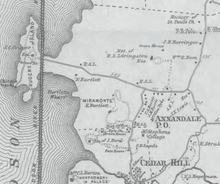
A map circa 1867 showing the various estates in the Town of Red Hook
During much of the nineteenth century, the land now owned by Bard was mainly composed of several country estates. These estates were called Blithewood, Bartlett, Sands, Cruger's Island, and Ward Manor/Almont.
In 1853, John Bard and Margaret Bard purchased a part of the Blithewood estate and renamed it Annandale. John Bard was the grandson of Samuel Bard, a prominent doctor, a founder of Columbia University's medical school, and physician to George Washington.[7] John Bard was also the nephew of the Rev. John McVickar, a professor at Columbia University. The family had strong connections with the Episcopal Church and Columbia.
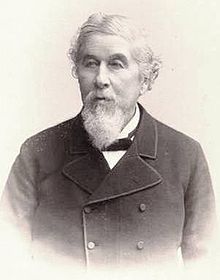
The following year, in 1854, John and Margaret established a parish school on their estate in order to educate the area's children. A wood-frame cottage, known today as Bard Hall, served as a school on weekdays and a chapel on weekends. In 1857, the Bards expanded the parish by building the Chapel of the Holy Innocents next to Bard Hall.[8] During this time, John Bard remained in close contact with the New York leaders of the Episcopal Church. The Church suggested that he found a theological college.[9]
With the promise of outside financial support, John Bard donated the unfinished Chapel, and the surrounding 18 acres (7.3 ha), to the diocese in November 1858. In March 1860, St. Stephen's College was founded. In 1861, construction began on the first St. Stephen's College building, a stone collegiate gothic dormitory called Aspinwall. During its initial years, the college relied on wealthy benefactors, like trustee Cornelius Vanderbilt, for funding.[10]
The college began taking shape within four decades. In 1866, Ludlow Hall, an administrative building, was erected. Preston Hall was built in 1873 and used as a refectory. A set of four dormitories, collectively known as Stone Row, were completed in 1891. And in 1895, the Greek revival Hoffman Memorial Library was built.[11] The school officially changed its name to Bard College in 1934 in honor of its founder.
Growth and secularization [edit]

Ward Manor House now serves as a dormitory
In the 20th century, social and cultural changes amongst New York's high society would bring about the demise of the great estates. In 1914, Louis Hamersley purchased the fire-damaged Ward Manor/Almont estate and erected a Tudor style mansion and gatehouse, or what is today known as Ward Manor.[12] Hamersley expanded his estate in 1926 by acquiring the abandoned Cruger's Island estate. That same year, after Hamersley's combined estate was purchased by William Ward, it was donated to charity and served as a retirement home for almost four decades.
By the mid-1900s, Bard's campus significantly expanded. The Blithewood estate was donated to the college in 1951, and in 1963, Bard purchased 90 acres (36 ha) of the Ward Manor estate, including the main manor house. The rest of the Ward Manor estate is now the 900-acre (360 ha) Tivoli Bays nature preserve.[13] [14]
In 1919, Fr. Bernard Iddings Bell became Bard's youngest president at the age of 34. His adherence to classical education, decorum, and dress eventually clashed with the school's push towards Deweyism and secularization, and he resigned in 1933.[15]
In 1928, Bard merged with Columbia University, serving as an undergraduate school similar to Barnard College. Under the agreement, Bard remained affiliated with the Episcopal Church and retained control of its finances. The merger raised Bard's prestige; however, it failed to provide financial support to the college during the Great Depression.[16] So dire was Bard's financial situation that in 1932, then-Governor of New York and College trustee Franklin D. Roosevelt sent a telegram to the likes of John D. Rockefeller, Jr., George Eastman and Frederick William Vanderbilt requesting donations for the college.[17]
On May 26, 1933, Dr. Donald Tewksbury, a Columbia professor, was appointed dean of the college. Although dean for only four years, Tewksbury had a lasting impact on the school. Tewksbury, an educational philosopher, had extensive ideas regarding higher education. While he was dean, Tewksbury steered the college into a more secular direction, and changed its name from St. Stephen's to Bard. He also placed a heavy academic emphasis on the arts, something atypical of colleges at the time, and set the foundations for Bard's Moderation and Senior Project requirement.[16] [18] While Tewksbury never characterized Bard's curriculum as "progressive," the school would later be considered an early adopter of progressive education. In his 1943 study of early progressive colleges, titled General Education in the Progressive College, Louis T. Benezet used Bard as one of his three case studies.[16] [19]
During the 1940s, Bard provided a haven for intellectual refugees fleeing Europe. These included Hannah Arendt, the political theorist, Stefan Hirsch, the precisionist painter; Felix Hirsch, the political editor of the Berliner Tageblatt; the violinist Emil Hauser; the linguist Hans Marchand; the noted psychologist Werner Wolff; and the philosopher Heinrich Blücher.[16] Arendt is buried at Bard, as is eminent novelist Philip Roth.[20]
In 1944, as a result of World War II, enrollment significantly dropped putting financial stress on the college. In order to increase enrollment, the college became co-educational, thereby severing all ties with Columbia. The college became an independent, secular, institution in 1944. Thus enrollment more than doubled, from 137 students in 1944, to 293 in 1947.[21] In the 1950s, with the addition of the Blithewood estate and Tewksbury Hall, the college would increase its enrollment by 150 students.
Late twentieth and early twenty-first century [edit]
The experiences of Donald Fagen and Walter Becker while at Bard caused them to write the 1973 song "My Old School" for their rock group, Steely Dan.[22] Fagen wrote another Steely Dan song, "Rikki Don't Lose That Number", about novelist, artist and former Bard faculty spouse Rikki Ducornet.[23]
In 2020, Bard College, along with Central European University, became the founding members of the Open Society University Network, a collaborative global education initiative endowed with US$1 billion. As part of this new initiative, the college received a US$100 million gift from the Open Society Foundations which ranks among the largest financial contributions to a U.S. institution in recent history.[24] [25]
In June 2021, Bard College was declared 'Undesirable' in Russia, becoming the first international higher education organization to be branded with this designation.[26] Bard president Botstein hypothesize that this tag was due their association with and funding from the Open Society Foundations (also classified 'undesirable' in Russia) and related conspiracies about George Soros.[27]
Campus [edit]

Faculty offices are located in Warden's Hall.
The campus of Bard College is in Annandale-on-Hudson, a hamlet in Dutchess County, New York, United States, in the town of Red Hook. It contains more than 70 buildings with a total gross building space of 1,167,090 sq ft (108,426 m2) and was listed as a census-designated place in 2020.[28] [29] Campus buildings represent varied architectural styles, but the campus remains heavily influenced by the Collegiate Gothic and Postmodern styles.
Bard's historic buildings are associated with the early development of the college and the history of the Hudson River estates (see Bard College History).[12] During a late twentieth-century building boom, the college embraced a trend of building signature buildings designed by prominent architects like Venturi, Gehry, and Viñoly.[30]
In January 2016, Bard purchased Montgomery Place, a 380-acre (150 ha) estate adjacent to the Bard campus, with significant historic and cultural assets. The estate consists of a historic mansion, a farm, and some 20 smaller buildings. The college purchased the property from Historic Hudson Valley, the historical preservation organization that had owned Montgomery Place since the late 1980s. The addition of this property brings Bard's total campus size to nearly 1,000 acres (400 ha) along the Hudson River in Annandale-on-Hudson, New York.[31]
Academics [edit]
Bard is a college of the liberal arts and sciences. In the undergraduate college, Bard offers Bachelor of Arts and Bachelor of Science degrees. There are 23 academic departments that offer over 40 major programs, as well as 12 interdisciplinary concentrations. The college was the first in the nation to offer a human rights major.[32] In the 2011–2012 academic year, the college held 1,345 classes.
In the three weeks preceding their first semester, first-year students attend the Language and Thinking (L&T) program, an intensive, writing-centered introduction to the liberal arts. The interdisciplinary program, established in 1981, aims to "cultivate habits of thoughtful reading and discussion, clear articulation, accurate self-critique, and productive collaboration."[33] The program covers philosophy, history, science, poetry, fiction, and religion. In 2011, the core readings included works by Hannah Arendt, Franz Kafka, Frans de Waal, Stephen Jay Gould, Clifford Geertz, M. NourbeSe Philip, and Sophocles.[34]
The capstone of the Bard undergraduate experience is the Senior Project, commonly referred to as SPROJ amongst its students.[35] As with moderation, this project takes different forms in different departments. Many students write a paper of around eighty pages, which is then, as with work for moderation, critiqued by a board of three professors. Arts students must organize a series of concerts, recitals, or shows, or produce substantial creative work; math and science students, as well as some social science students, undertake research projects.
Rankings and admissions [edit]
| Academic rankings | |
|---|---|
| Liberal arts colleges | |
| U.S. News & World Report [36] | 54 |
| Washington Monthly [37] | 81 |
| National | |
| Forbes [38] | 230 |
| THE/WSJ [39] | 264 |
In its 2021 edition of college rankings, U.S. News & World Report ranked Bard tied for 54th overall, 4th in "Most Innovative Schools", tied at 30th for "Best Undergraduate Teaching", and 40th for "Best Value" among liberal arts colleges in the United States.[40]
In September 2011, Travel+Leisure named the college as one of the most beautiful campuses in the United States.[41]
Bard has been named a top producer of U.S. Fulbright Scholars.[42] Many Bard alumni have also been named Watson Fellows, Critical Language Scholarship recipients, Davis Projects for Peace Prize winners, Rhodes Scholars, Marshall Scholars, and Peace Corps fellows, among other postgraduate awards.[43] [44] [45] [46]
Endowment [edit]
Bard has access to multiple, distinct endowments. Bard, along with Central European University, is a founding member of the Open Society University Network, endowed with $1 billion.[47] Bard also maintains a separate endowment of approximately $267 million, a large portion of which is exclusively dedicated to its graduate programs in the arts.[48] In July 2020, Bard received a gift of $100 million from the Open Society Foundations, which will dispense $10 million yearly over a period of ten years.[49] In April 2021, Bard received a $500 million endowment challenge grant from philanthropist George Soros. Once matched, on a five-year timeline, Bard will have an endowment of more than $1 billion.[50]
Programs, centers, and associated institutes [edit]
Bard has developed several innovative graduate programs and research institutes, including the Milton Avery Graduate School of the Arts, the Levy Economics Institute which began offering a Masters of Science in Economic Theory and Policy in 2014, the Center for Curatorial Studies and Art in Contemporary Culture, the Bard Center for Environmental Policy, the Bard College Conservatory of Music, the ICP-Bard Program in Advanced Photographic Studies in Manhattan,[51] the Master of Arts in Teaching Program (MAT), the Bard College Clemente Program, and the Bard Graduate Center in Manhattan.

Interior view of the Gehry-designed Fisher Center
In 1990, Bard College acquired, on permanent loan, art collector Marieluise Hessel's substantial collection of important contemporary artwork. In 2006, Hessel contributed another $8 million (USD) for the construction of a 17,000-square-foot addition to Bard's Center for Curatorial Studies building, in which the collection is exhibited.[52]
The Bard Prison Initiative (BPI) provides a liberal arts degree to incarcerated individuals (prison education) in five prisons in New York state, and enrolls nearly 200 students.[53] Since federal funding for prison education programs was eliminated in 1994,[54] BPI is one of only a small number of programs of its kind in the country.[53]
Bard awards the Bard Fiction Prize annually to "a promising emerging writer who is an American citizen aged 39 years or younger at the time of application". The prize is $30,000 and an appointment as writer-in-residence at the college.[55]
The Hannah Arendt Center for Politics and Humanities is located at Bard College. The center hosts an annual public conference, offers courses, runs various related academic programs, and houses research fellows,[56] and is directed by Dr. Roger Berkowitz, a legal scholar and an associate professor of politics, philosophy, and human rights.[57]
In February 2009, Bard announced the first dual degree program between a Palestinian university and an American institution of higher education. The college entered into a collaboration with Al-Quds University involving an honors college, a master's program in teaching and a model high school.[58]
In accordance with AlQuds-Bard requirements, students are not allowed to decide their major during the first year of their studies; instead, as a liberal arts college, students are advised to diverge in different classes that would allow them to decide what program they would like to take interest in as in the following year. Students are encouraged to look upon different classes to help them decide the subject they would mostly enjoy studying. Bard gives students the opportunity to dissect different programs before committing to a specific major. As a policy, throughout a student's undergraduate years, they must distribute their credits among different courses so that they can liberally experience the different courses Bard has to offer.[59]
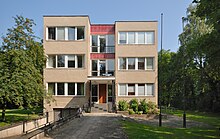
In June 2011, Bard officially acquired the Longy School of Music in Boston,[60] and in November 2011, Bard took ownership of the European College of Liberal Arts in Berlin, Germany, to become Bard College Berlin.[61]
In 2013, Bard entered into a comprehensive agreement with Soochow University in Suzhou, China, that will include a joint program between the Soochow University School of Music and the Bard College Conservatory of Music, exploration leading to the establishment of The Bard College Liberal Arts Academy at Soochow University, and student exchange.[62]
In 2020, Bard announced that through the new Franklin and Eleanor Roosevelt Advanced Achievement Scholars program the college will offer admission to high school juniors within 120 miles from the college based on an essay process based on the popular Bard Entrance Exam, first launched in 2013.[63]
Student life [edit]
Over 120 student clubs are financed through Bard's Convocation Fund, which is distributed once a semester by an elected student body and ratified during a public forum. Bard College has one print newspaper, the Bard Free Press, which was awarded a Best in Show title by the Associated Collegiate Press in 2013.[64] In 2003, the Bard Free Press won Best Campus Publication in SPIN Magazines first annual Campus Awards.[65] Student-run literary magazines include the semiannual Lux, The Moderator, and Sui Generis, a journal of translations and of original poetry in languages other than English. The Draft, a human rights journal, the Bard Journal of the Social Sciences, Bard Science Journal, and Qualia, a philosophy journal, are also student-published. Bard Papers is a privately funded literary magazine operated jointly between faculty and students.
Other prominent student groups include: the International Students Organization (ISO), Afropulse, Latin American Student Organization (LASO), Caribbean Student Association (CSA), Asian Student Organization (ASO), Black Student Organization (BSO), Anti-Capitalism Feminist Coalition, Body Image Discussion Group, Self-Injury Support and Discussion, Bard Film Committee, Queer Student Association, Trans Life Collective, The Scale Project, Student Labor Dialogue, Bard Debate Union, Bard Model UN, Surrealist Training Circus, Bard Bike Co-Op, Bard Bars, Bard POC Theater Ensemble, and college radio station WXBC.[66] WXBC was founded in 1947.[67] In 2006, WXBC was nominated for "Station of the Year" and "Biggest Improvement" in the CMJ College Radio Awards.[68]
Bard has a strong independent music scene considering its isolation and size. The college's Old Gym was once a popular location for concerts and parties in the 1980s, 1990s, and early 2000s. In 2004, the Old Gym was shut down and in spring 2006 transformed into a student-run theater by students Brel Froebe, Julie Rossman, and Kell Condon. Many activities that once took place there now occur in the smaller SMOG building. SMOG is now primarily used as a music venue featuring student-run bands.[69] Student-run theater is also popular: dozens of student directed and written productions are put on each semester and a 24 Hour Theater Festival is held at least once a year.
Athletics [edit]
Bard College teams participate as a member of the National Collegiate Athletic Association's Division III. The Raptors are a member of the Liberty League. Prior conference affiliations include the Skyline Conference and the former Hudson Valley Athletic Conference. Women's sports include basketball, cross country, lacrosse, soccer, swimming & diving, tennis, track & field, volleyball and squash. Men's sports include baseball, basketball, cross country, lacrosse, soccer, squash, swimming & diving, tennis, track & field and volleyball.
One of the more popular club sports on campus is rugby. Bard College Rugby Football Club fields men's and women's teams that compete in the Tristate Conference, affiliated with National Collegiate Rugby. Additional club sports include: ultimate frisbee, fencing, and equestrian.[70]
Alumni and faculty [edit]
- Notable Bard alumni
-

-

-

-

-

-

-

-

- Notable Bard faculty
-

-

Notable alumni of Bard include fraternal songwriters Richard M. Sherman and Robert B. Sherman, comedian and actor Chevy Chase (1967); Walter Becker and Donald Fagen of Steely Dan (1969); actors Blythe Danner (1965) Adrian Grenier, Gaby Hoffmann, Larry Hagman; filmmakers Gia Coppola, Todd Haynes (MFA), Sadie Bennings (MFA), Lana Wachowski (dropped out); Herb Ritts, photographer; Christopher Guest, actor/director (This is Spinal Tap, Waiting for Guffman, Best in Show); songwriters Billy Steinberg (Madonna's "Like A Virgin," Cyndi Lauper's "True Colors," The Bangles "Eternal Flame"); Anne Bogart, theater director; Howard E. Koch, screenwriter (Casablanca, Letter from an Unknown Woman); David Cote, writer; Adam Conover, comedian and creator of Adam Ruins Everything; Raphael Bob-Waksberg, comedian and creator of Bojack Horseman; classical composer Bruce Wolosoff; Ronan Farrow, journalist who exposed the Harvey Weinstein scandal; writer and social theorist Albert Jay Nock, journalist and author Matt Taibbi, and Adam Yauch of the Beastie Boys. Other notable alumni include artist Freya Powell[71] and Tschabalala Self.[72]
Among the college's most well-known former faculty are Hannah Arendt, Toni Morrison, Heinrich Blücher, Roy Lichtenstein, Mary McCarthy, Arthur Penn, John Ashbery, Richard Teitelbaum and Chinua Achebe. Current faculty who are well-known include Neil Gaiman, Bill T. Jones, Daniel Mendelsohn and Joan Tower.[73]
Gallery [edit]
-
Franklin W. Olin Humanities Building
-
Chapel of the Holy Innocents
-
-
Milton and Sally Avery Arts Center
-
-
-
-
-
-

-
References [edit]
- ^ "About". Bard.edu.
- ^ "Student Services". Bard.edu. Archived from the original on August 10, 2014. Retrieved August 9, 2014.
- ^ "Bard Athletics and Recreation". Bard.edu. Archived from the original on December 26, 2010. Retrieved July 8, 2011.
- ^ "At a Glance". Bard College. Bard College. Retrieved August 9, 2014.
- ^ "Bard College". The Princeton Review. Retrieved July 12, 2012.
- ^ "Institutes". Bard College. Archived from the original on June 29, 2012. Retrieved July 10, 2012.
- ^ Hirsch, Felix (October 1941). "The Bard Family". Columbia University Quarterly. Bard College Archives, Annandale-on-Hudson, NY.
- ^ Kline, Reamer (1982). Education for the Common Good: A History of Bard College The First 100 Years, 1860-1960. Annandale-on-Hudson, NY: Bard College. p. 15.
- ^ Hopson, George (1910). Reminiscences of St. Stephen's College. New York, NY: Edwin S. Gorham. pp. 16–17.
- ^ Magee, Christopher (1950). The History of St. Stephen's College 1860-1933. Annandale-on-Hudson, NY: Bard College Senior Project. p. 38.
- ^ John Milner Associates Inc. (December 2008). Bard College Master Preservation Plan (Report). p. 27.
- ^ a b Kline, Reamer (1982). Education for the Common Good: A History of Bard College The First 100 Years, 1860-1960. Annandale-on-Hudson, NY: Bard College.
- ^ "Bard College Archives". Bard College. Archived from the original on June 1, 2013. Retrieved July 11, 2012.
- ^ John Milner Associates Inc. (December 2008). Bard College Master Preservation Plan (Report). p. 34.
- ^ Kirk, Russell (1963). Confessions of a Bohemian Tory. Fleet Publishing Corporation. p. 162.
- ^ a b c d "About Bard | History of Bard". Bard.edu. May 21, 2011. Archived from the original on June 14, 2011. Retrieved July 8, 2011.
- ^ Kline, Reamer (1982). Education for the Common Good: A History of Bard College The First 100 Years, 1860-1960 (PDF). Annandale-on-Hudson, NY: Bard College. p. 99.
- ^ Kline, Reamer (1982). Education for the Common Good: A History of Bard College The First 100 Years, 1860-1960 (PDF). Annandale-on-Hudson, NY: Bard College. p. 104.
- ^ Kline, Reamer (1982). Education for the Common Good: A History of Bard College The First 100 Years, 1860-1960 (PDF). Annandale-on-Hudson, NY: Bard College. p. 106.
- ^ "Hannah Arendt Center News". hac.bard.edu . Retrieved December 29, 2018.
- ^ Kline, Reamer (1982). Education for the Common Good: A History of Bard College The First 100 Years, 1860-1960 (PDF). Annandale-on-Hudson, NY: Bard College. p. 120.
- ^ Brunner, Rob (March 17, 2006). "The origins of Steely Dan". Entertainment Weekly . Retrieved December 12, 2019.
- ^ McCormack, J.W. (May 20, 2016). "The Burden of Strangeness: Rikki Ducornet". PWxyz, LLC. Retrieved December 12, 2019.
- ^ "Open Society Foundations Gives Bard $100 Million | Inside Higher Ed". www.insidehighered.com.
- ^ https://www.chronicle.com/article/Major-Private-Gifts-to-Higher/128264.
- ^ Redden, Elizabeth (July 9, 2021). "Bard College Declared 'Undesirable' in Russia". Inside Higher Ed . Retrieved August 5, 2021.
- ^ Fischer, Karin (June 22, 2021). "Bard President Is 'Heartbroken' About Russian Blacklisting". Chronicle of Higher Education . Retrieved August 5, 2021.
- ^ "GHG Report for Bard College". American College & University Presidents' Climate Commitment. Archived from the original on January 27, 2013. Retrieved April 24, 2013.
- ^ "State of New York Census Designated Places - Current/BAS20 - Data as of January 1, 2019". U.S. Census Bureau. January 1, 2019. Retrieved February 8, 2020.
- ^ "Facilities". Bard College. Retrieved April 24, 2013.
- ^ Kemble, William J. (January 13, 2016). "Bard College completes $18M purchase of Montgomery Place". dailyfreeman.com. Daily Freeman. Retrieved February 29, 2016.
- ^ "Bard College Catalogue". Bard College. Retrieved July 11, 2012.
- ^ "Language and Thinking". Bard College. Retrieved July 11, 2012.
- ^ "Language and Thinking Anthology". Bard College. Archived from the original on January 23, 2013. Retrieved July 11, 2012.
- ^ College, Bard. "Undergraduate Curriculum at Bard College". www.bard.edu.
- ^ "Best Colleges 2021: National Liberal Arts Colleges". U.S. News & World Report . Retrieved September 24, 2020.
- ^ "2021 Liberal Arts Rankings". Washington Monthly . Retrieved September 9, 2021.
- ^ "America's Top Colleges 2021". Forbes . Retrieved September 9, 2021.
- ^ "Wall Street Journal/Times Higher Education College Rankings 2021". The Wall Street Journal/Times Higher Education . Retrieved October 20, 2020.
- ^ "Bard College Rankings". U.S. News & World Report. 2021. Retrieved October 3, 2020.
- ^ "America's Most Beautiful College Campuses". Travel + Leisure.
- ^ Relations, Bard Public. "Bard College Named a Top Producer of Fulbright U.S. Students and U.S. Scholars for 2019–20". www.bard.edu.
- ^ Relations, Bard Public. "Two Bard College Seniors Win Prestigious Watson Travel Fellowships | Bard College Public Relations". www.bard.edu.
- ^ Relations, Bard Public. "Two Bard College Students Win Critical Language Scholarships for Foreign Language Study Abroad | Bard College Public Relations". www.bard.edu.
- ^ Relations, Bard Public. "Bard College Student Wins Davis Projects For Peace Prize". www.bard.edu.
- ^ Relations, Bard Public. "Bard College Alumnus Ronan S. Farrow '04 Awarded Prestigious Rhodes Scholarship | Bard College Public Relations". www.bard.edu.
- ^ Relations, Bard Public. "Bard College and Partners Establish Global Network to Transform Higher Education". www.bard.edu.
- ^ "Bard College: Rankings, Courses, Admissions, Tuition Fee, Cost of Attendance & Scholarships". Collegedunia. May 6, 2020.
- ^ https://osun.bard.edu/newsroom/osf-100-million-bard-college-strengthening-global-network.
- ^ Adams, Susan (April 1, 2021). "George Soros Is Giving $500 Million To Bard College". Forbes . Retrieved May 5, 2021.
- ^ "ICP-Bard MFA". May 16, 2016. Retrieved July 26, 2018.
- ^ Bloomberg (November 10, 2006). "Marieluise Hessel Builds a Museum at Bard for Her Collection". Bloomberg.com. Retrieved November 20, 2013.
- ^ a b "Bard Prison Initiative". Bard.edu. Archived from the original on August 9, 2011. Retrieved July 8, 2011.
- ^ "Maximum Security Education". CBS News. April 15, 2007.
- ^ "Bard College - Bard Fiction Prize". www.bard.edu.
- ^ Hannah Arendt Center, January 5, 2018
- ^ Hannah Arendt Center: About, January 5, 2018
- ^ Palestinian Campus Looks to East Bank (of Hudson), New York Times, February 14, 2009
- ^ AlQuds Bard Requirements, March 29, 2017
- ^ Eichler, Jeremy (September 12, 2011). "After Longy-Bard merger, a music school peers into its future". Boston Globe . Retrieved August 9, 2014.
- ^ "History". Bard College Berlin. Bard College Berlin. Retrieved August 9, 2014.
- ^ Mark, Primoff (June 24, 2013). "Bard College and Soochow University in China Agree to Comprehensive Partnership, including the Creation of a Joint Music Program, Student Exchange, and the Bard College Liberal Arts Academy in Soochow University". News & Events. Bard College. Retrieved August 9, 2014.
- ^ Relations, Bard Public. "Bard College Offers Unique Admission Program for High School Juniors". www.bard.edu . Retrieved May 7, 2020.
- ^ Associated Collegiate Press. "ACP Best of Show Winners". Studentpress.org. Archived from the original on December 3, 2013. Retrieved November 19, 2013.
- ^ "The Bard Free Press". August 26, 2007. Archived from the original on July 19, 2011. Retrieved July 8, 2011.
- ^ College, Bard. "Bard Student Clubs at Bard College". studentactivities.bard.edu . Retrieved May 7, 2020.
- ^ "About WXBC", WXBC. Retrieved March 11, 2019.
- ^ CMJ College Radio Awards Nominees Archived May 16, 2009, at the Wayback Machine College Music Journal November 16, 2006
- ^ "SMOG". Student.bard.edu. Archived from the original on December 11, 2008. Retrieved July 8, 2011.
- ^ "Club Sports". Bard College Athletics.
- ^ "Only Remains Remain | Magazine". www.moma.org . Retrieved May 7, 2020.
- ^ Kazanjian, Dodie. "Artist Tschabalala Self Upends Our Perception of the Female Form". Vogue . Retrieved May 7, 2020.
- ^ "The Bard Professor Who Was Named Composer of the Year". Hudson Valley Magazine. January 21, 2020. Retrieved May 7, 2020.
External links [edit]
- Official website
- Official athletics website
Bard College Creative Writing Mfa
Source: https://en.wikipedia.org/wiki/Bard_College


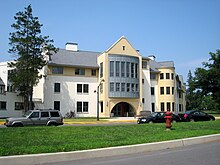

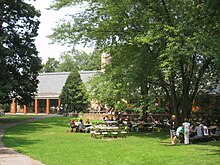
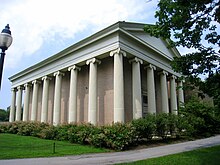




0 Response to "Bard College Creative Writing Mfa"
Post a Comment